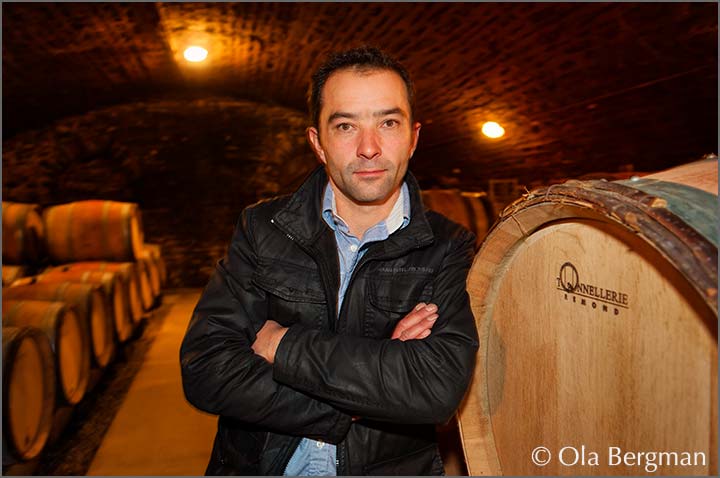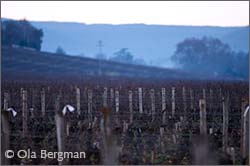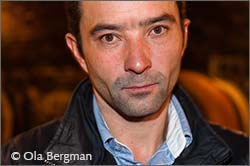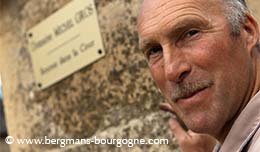
n recent years Guillaume Camus at Domaine Camus-Bruchon in Savigny-lès-Beaune has seen his village being hit badly by hail. But he has also seen a growing interest for the appellation.
– Since the financial crisis in 2008 the interest for Savigny-lès-Beaune has grown, he says. It offers a good price/quality ratio and because of that there are more importers looking for it.
 The only problem is that the hail has reduced the size of the crops, in some cases to close to nothing, so there isn’t much wine available. On several occasions this part of the Côte d’Or has suffered badly from hailstorms. So if you have an estate like Domaine Camus-Bruchon, with vineyards in Savigny-lès-Beaune, Beaune and Pommard, you’re right in the middle of the hailstorms’ favourite part of Burgundy.
The only problem is that the hail has reduced the size of the crops, in some cases to close to nothing, so there isn’t much wine available. On several occasions this part of the Côte d’Or has suffered badly from hailstorms. So if you have an estate like Domaine Camus-Bruchon, with vineyards in Savigny-lès-Beaune, Beaune and Pommard, you’re right in the middle of the hailstorms’ favourite part of Burgundy.
By Burgundian standards Domaine Camus-Bruchon is young domaine. Guillaume Camus stresses the word only when he explains that he is only the third generation to run the domaine.
 – It’s a family business, created by my grandmother, he says. Originally it was quite modest in size. Something like five hectares. In the 1950’s and the 1960’s my grandmother, despite having limited resources, managed to buy quite a lot of land. Today we have nine hectares.
– It’s a family business, created by my grandmother, he says. Originally it was quite modest in size. Something like five hectares. In the 1950’s and the 1960’s my grandmother, despite having limited resources, managed to buy quite a lot of land. Today we have nine hectares.
The majority of the domaine’s vineyards are located in Savigny-lès-Beaune. Guillaume Camus produces three different cuvées of village Savigny-lès-Beaune as well as three premier crus. Up until the 1970’s nothing was bottled at the domaine. All wine was sold to négociants. Today most of the production is bottled at Domaine Camus-Bruchon.
 – One cuvée is a blend from different parcels, both from the slopes and from the plain, says Guillaume Camus. The other two cuvées are from old vines. Les Pimentiers was planted in 1927. It’s a parcel down on the flat part, towards the route nationale and Chorey-lès-Beaune. The other is Aux Grands Liards, which is just east of the village, below the premier cru Les Lavières. It was planted in 1913 and 1922.
– One cuvée is a blend from different parcels, both from the slopes and from the plain, says Guillaume Camus. The other two cuvées are from old vines. Les Pimentiers was planted in 1927. It’s a parcel down on the flat part, towards the route nationale and Chorey-lès-Beaune. The other is Aux Grands Liards, which is just east of the village, below the premier cru Les Lavières. It was planted in 1913 and 1922.
The blend comes from Aux Champs des Pruniers, Aux Fourches, Les Planchots du Nord and Clos des Pointes. There is also a white village Savigny-lès-Beaune from Les Goudelettes, which is on the steeper parts behind the village. There is also another white Savigny-lès-Beaune cuvée, as well as a Bourgogne blanc, which are sold to négociants.
 – I have been working at the domaine since 1997, says Guillaume Camus. First together with my father, but since 2010 I have done every vintage myself. I haven’t changed much. I’m maintaining the style of the domaine, the style that our clients like.
– I have been working at the domaine since 1997, says Guillaume Camus. First together with my father, but since 2010 I have done every vintage myself. I haven’t changed much. I’m maintaining the style of the domaine, the style that our clients like.
In the vineyards Guillaume Camus works along the principles of lutte raisonnée, sustainable farming. He is trying to minimise the use of chemicals as much as possible.
 – We do a lot of manual work in the vineyards. We green harvest if necessary. My father started deleafing in 1978. We harvest by hand. But unlike other domaines we do not use a sorting table. Instead we employ a lot of people at harvest and we do the sorting in the vineyards. So when the cases going to the winery are filled there are only healthy grapes in there. At the winery about 80 per cent of the grapes are de-stemmed.
– We do a lot of manual work in the vineyards. We green harvest if necessary. My father started deleafing in 1978. We harvest by hand. But unlike other domaines we do not use a sorting table. Instead we employ a lot of people at harvest and we do the sorting in the vineyards. So when the cases going to the winery are filled there are only healthy grapes in there. At the winery about 80 per cent of the grapes are de-stemmed.
The Chorey-lès-Beaune of Domaine Camus-Bruchon comes from a single parcel in Le Grand Saussy, just north of the village’s cemetery and not far from the border to Ladoix-Serrigny. This is east of the route nationale, on the flatter parts with deeper soil.
The average age of the vines at Domaine Camus-Bruchon is relatively high. Often as high as 60 years. The three Savigny-lès-Beaune premier crus of the domaine – Les Gravains, Les Lavières and Les Narbantons – have an average age of 40 years, 60 years and 60 years respectively.
 – Les Gravains is at the end of the valley in Savigny-lès-Beaune, where it opens up into the flatter parts. The soil is special in the sense that it is very stony. 30–40 centimeters down you have more clay and limestone, almost sandy. It is white soil and Les Gravains produces a wine which is relatively powerful, but with a very good structure.
– Les Gravains is at the end of the valley in Savigny-lès-Beaune, where it opens up into the flatter parts. The soil is special in the sense that it is very stony. 30–40 centimeters down you have more clay and limestone, almost sandy. It is white soil and Les Gravains produces a wine which is relatively powerful, but with a very good structure.
– My parcel in Les Gravains is 40 ares (0.40 ha). The one in Les Lavières has about the same size. But the style of Les Lavières is very different to Les Gravains. The soil is silty, quite heavy and deep, with flat stones below. It’s a very supple wine with freshness and elegance.
– Les Narbantons is south of Savigny-lès-Beaune, explains Guillaume Camus, exposed northeast. The soil is not very deep. It is clay and limestone. This produces a wine with more power, balance and complexity. Very interesting I think.
Savigny-lès-Beaune is a large appellation, covering 346 hectares just north of Beaune. Its two sides, with slopes facing in almost opposite directions, produce wines of distinctly different characters.
– On the Les Narbantons and Les Marcaonnets side, the southern side next to the Paris motorway you get wines which are more about richness and power. On the other side, where you’ll find Les Gravains and Les Lavières, you get wines which have good length, but since these vineyards are facing straight south they express more of elegance. With vineyards facing north you get more of austerity.
© 2015 Ola Bergman














